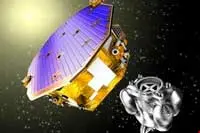 Results following two months’ of science operations show the two cubes at the heart of the LISA Pathfinder spacecraft are falling freely through space, influenced only by gravity and unperturbed by other external forces. And, says the European Space Agency (ESA), the precision is more than five times better than originally required.
Results following two months’ of science operations show the two cubes at the heart of the LISA Pathfinder spacecraft are falling freely through space, influenced only by gravity and unperturbed by other external forces. And, says the European Space Agency (ESA), the precision is more than five times better than originally required.
Detecting gravitational waves requires a sensing system operating at frequencies between 0.1mHz and 1Hz and the ability to measure tiny fluctuations in distance between objects placed millions of kilometres apart. LISA Pathfinder was designed to demonstrate key technologies needed to build such an observatory.
In the satellite, a pair of identical 2kg 46mm gold–platinum cubes 38cm apart are shielded from external influences, with the satellite adjusting its position constantly to avoid hitting them.
According to the team, the test masses are almost motionless with respect to each other, with a relative acceleration lower than 1 part in 10-14 of the Earth’s gravity.
“LISA Pathfinder’s test masses are now still with respect to each other to an astonishing degree,” said Alvaro Giménez, ESA’s director of science. “This is the level of control needed to enable the observation of low frequency gravitational waves with a future space observatory.”
LISA Pathfinder was launched on 3 December 2015, reaching its operational orbit roughly 1.5million km from Earth towards the Sun in late January 2016.
Mission operations started on 1 March 2016, with scientists performing a series of experiments to measure and control the different aspects and to determine how still the masses were. The first two months of data are said to show that, for frequencies between 60mHz and 1Hz, LISA Pathfinder’s precision is only limited by the sensing noise of the laser measurement system used to monitor the position and orientation of the cubes.
Author
Graham Pitcher
Source: www.newelectronics.co.uk

